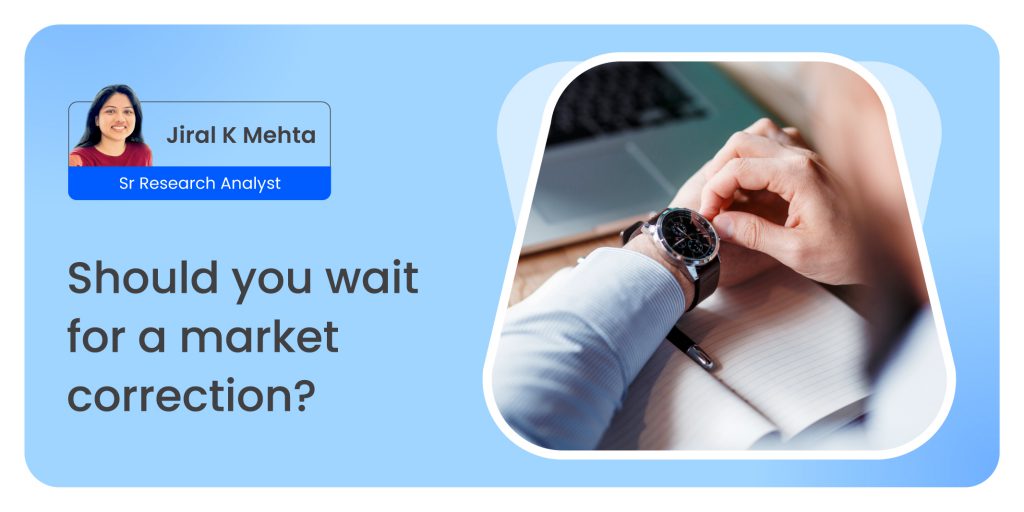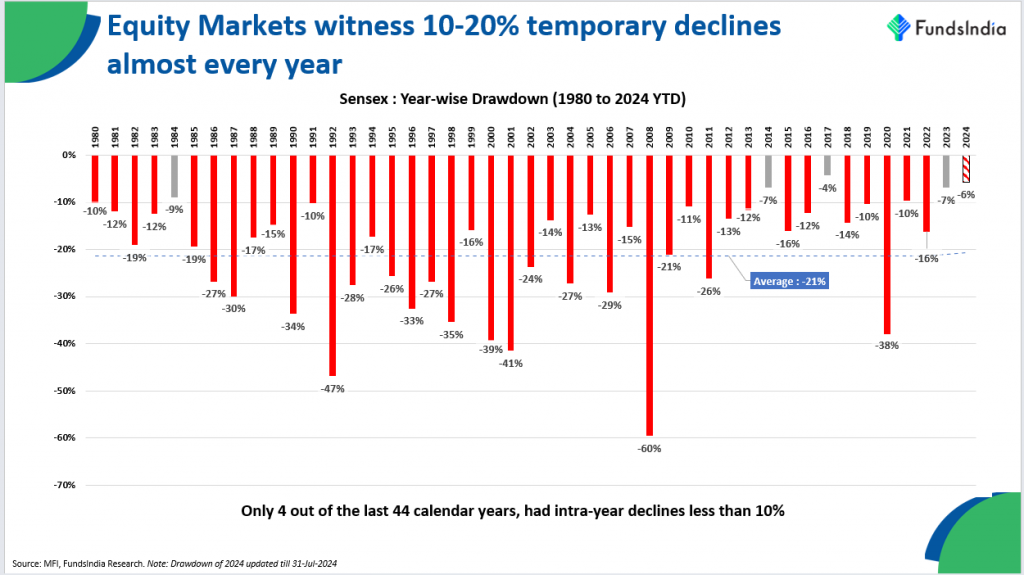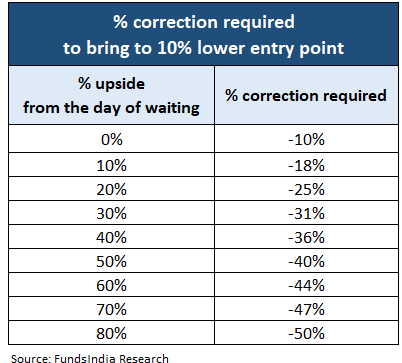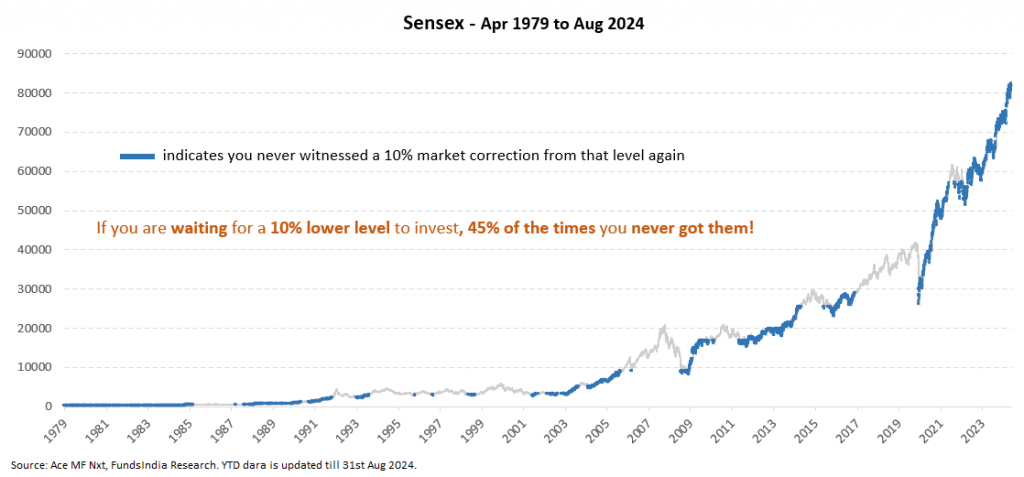Whenever you have money to invest in equities, a nagging thought inevitably comes up.
“Feels like markets could correct from here. Maybe I should wait and invest after a 10% correction”
Intuitively, waiting for a correction seems like a prudent approach.
But is this tactic really as effective as it feels?
Let’s find out…
For a better understanding of market declines, let’s look at history. In the below chart, you can see the calendar year-wise drawdowns for Sensex over the last 44+ years.
Every year saw a temporary market correction. EVERY SINGLE YEAR!
40 out of the 44 years had intra-year declines of more than 10%!
Takeaway: 10-20% temporary decline every year is almost a given!
So, if a 10-20% decline occurs almost every year then does it not make sense to wait for this decline to invest new money?
Simple. Wait for the correction of 10% and invest the lump sum amount when it occurs.
Looks intuitive and logical.
However there are 4 challenges that a ‘waiting for a 10% correction’ strategy throws up.
Challenge 1: If markets continue to go up, the correction needed to re-enter will have to be much larger than a 10% fall
If you’re waiting to invest after a 10% correction but the market continues to rally, the pullback required to re-enter will no longer be just 10%. You’ll need a larger correction to invest again at the same levels.
For example, in April 2024, when the Sensex was at 75,000, you decided to wait for a 10% correction (down to 67,500) before investing. However, in the past few months, the market has gone up ~13%, reaching 85,000. Now, you would need a 20% correction to reach the same 67,500 level—far more than the original 10% you planned for.
In short, if the market doesn’t correct as you expect and continues to rise, the drop required to get in at your target price becomes significantly higher than 10%.
Challenge 2: 45% of the times you never got a 10% lower entry point!
In the chart below, we’ve analyzed Sensex data from 1979 to the present (Aug-2024), covering more than 45 years. For each day in this period, we examine the chances of the market dropping 10% from that day’s level if you decide to wait.
For instance, on March 24, 2020, the Sensex was at 26,674. A 10% correction would bring it down to 24,000. We then check if, between March 25, 2020, and August 31, 2024, the Sensex ever fell below 24,000.
And here comes the shocker!
45% of the time, the market never dropped by 10% from the level where you waited.
This might seem to contradict our earlier finding that 10-20% declines happen almost every year.
But here’s the nuance: while these corrections are common, they don’t always happen immediately. They can occur at any point in the future, often from much higher levels than where you initially decided to wait.
The issue with holding off for a 10% correction is the uncertainty and the large odds of not getting the required 10% lower levels.
Since we don’t know when or at what level the correction will start, it’s difficult to predict if you’ll be in the 55% of the time when a 10% drop eventually occurs, or in the 45% of cases where it never happens.
Challenge 3: The cost of waiting can be very high if you get it wrong!
From what we’ve discussed so far, it’s clear that predicting the exact level from which market corrections will occur is challenging. But what if you decide to wait for that correction?
Historically, markets experience a 10% correction about 55% of the time. So, while you might not see a dip today, it could happen next month, or the month after. The question is: how long should you wait?
Typically, investors are willing to wait 1-2 years for a correction before they lose patience and start reconsidering their strategy. Let’s see if waiting for this period helps.
Using the Sensex as a reference, we analyzed how often a 10% correction occurred within 1-2 years from any given day. For example, on March 24, 2020, the Sensex stood at 26,674, so we checked whether it fell to 24,006 (a 10% drop) within the following year (March 25, 2020 – March 24, 2021) and within the next two years (March 25, 2020 – March 24, 2022).
Findings:
- ~50% of the time, the market gave you a 10% correction level if you waited 1-2 years.
- If you believe waiting beyond two years increases your chances, it doesn’t. Since markets only see a 10% correction 55% of the time in total, there’s just an additional 5% chance it might happen after two years. But waiting that long rarely makes sense.
Conclusion:
If you’re waiting for a 10% correction, the strategy works best within a 1-2 year window. However, there is a cost to waiting.
If the market doesn’t correct within 1-2 years and continues to rally, you miss out on those gains. The missed returns compound over time, amplifying the cost of staying out of the market.
The Cost of Waiting:
In the table below, we calculated the potential returns you miss when the market doesn’t experience a 10% correction within 1-2 years:
- On average, you miss out on 33% to 60% upside.
- In extreme cases, you could miss a 260% to 475% upside, meaning you would have missed the opportunity to multiply your initial investment by 3 to 6 times.
Key Takeaway:
While waiting for a 10% correction over a 1-2 year period can sometimes work, the cost of missing out on significant market rallies can be steep. In some cases, the returns foregone by waiting could end up being far higher than what you’d gain by catching that correction.
Challenge 4 – Behaviorally it’s hard to enter back at higher levels
When you’re stuck waiting for a 10% correction that never comes and the market continues to rally, it becomes psychologically challenging to re-enter.
Two key factors make this difficult:
- Accepting you were wrong: By choosing to invest at higher levels after waiting for a correction that didn’t happen, you’re essentially admitting that your decision to hold off was incorrect. This admission is psychologically hard to accept, and the discomfort of being “wrong” can prevent you from re-entering at higher levels.
- Capturing a permanent loss: If the market doesn’t correct and instead keeps going up, you miss out on all the potential gains during that time. When you eventually re-enter at higher levels, you’ve effectively locked in those missed returns, which becomes a permanent loss in your portfolio. This missed opportunity is often overlooked when calculating overall returns.
What should you do?
- The dilemma of investing now vs waiting for a correction to invest will arise many times throughout your investment journey so it is important to accept this as normal.
- But, ‘waiting for a correction’ strategy usually backfires because of these 4 challenges,
Challenge 1 – If markets continue going up over time, then the required correction to enter back also increases and is much more than just a 10% correction.
Challenge 2 – 45% of the times you never got a 10% lower entry point!
Challenge 3 – The cost of waiting can be very high if you get it wrong!
Challenge 4 – Behaviorally, it’s hard to enter back at higher levels
- To avoid this psychological urge to keep waiting for a market correction (read as trying to time the markets), it is important to have a predetermined rule based framework to deploy lumpsum money. You can choose to deploy lumpsum immediately or if you are valuation conscious then you can invest a portion now and stagger the remaining using a 3-6 months STP.
- At FundsIndia, we follow a Lumpsum Deployment Framework based on FundsIndia Valuemeter (our in-house valuation indicator). Through this framework a portion of the lumpsum is immediately invested and the remaining is staggered via 3-6 months STP. As a general principle, we deploy faster when valuations are lower, and slower when valuations are expensive.














